There’s something deeply satisfying about a hearty, rich soup that warms you down to your bones – and this Vegetable Beef Soup with Guinness and Vegetables Recipe does just that. It's a comforting hug in a bowl, blending tender beef, robust Guinness, and fresh vegetables for a taste that's simply unforgettable.
Jump to:
- Why You'll Love This Recipe
- Ingredients & Why They Work
- Make It Your Way
- Step-by-Step: How I Make Vegetable Beef Soup with Guinness and Vegetables Recipe
- Top Tip
- How to Serve Vegetable Beef Soup with Guinness and Vegetables Recipe
- Make Ahead and Storage
- Frequently Asked Questions:
- Final Thoughts
- Vegetable Beef Soup with Guinness and Vegetables Recipe
Why You'll Love This Recipe
I adore this soup because it feels special without being fussy. It’s a one-pot meal that transforms affordable ingredients into something that tastes like it took hours in the kitchen. Plus, the Guinness adds that extra depth you just don’t get from many other soups.
- Rich Flavor Boost: The Guinness (or stout or even a good red wine) gives the broth a velvety, deep flavor that’s absolutely addictive.
- Tender, Fall-Apart Beef: Using stewing beef and slow simmering means every bite melts in your mouth.
- Nutritious Comfort: Packed with wholesome vegetables like potatoes, carrots, celery, and peas—so it’s filling and nourishing.
- Simple Yet Elegant: It’s not complicated, but it feels celebratory enough to serve guests or family on a cozy night in.
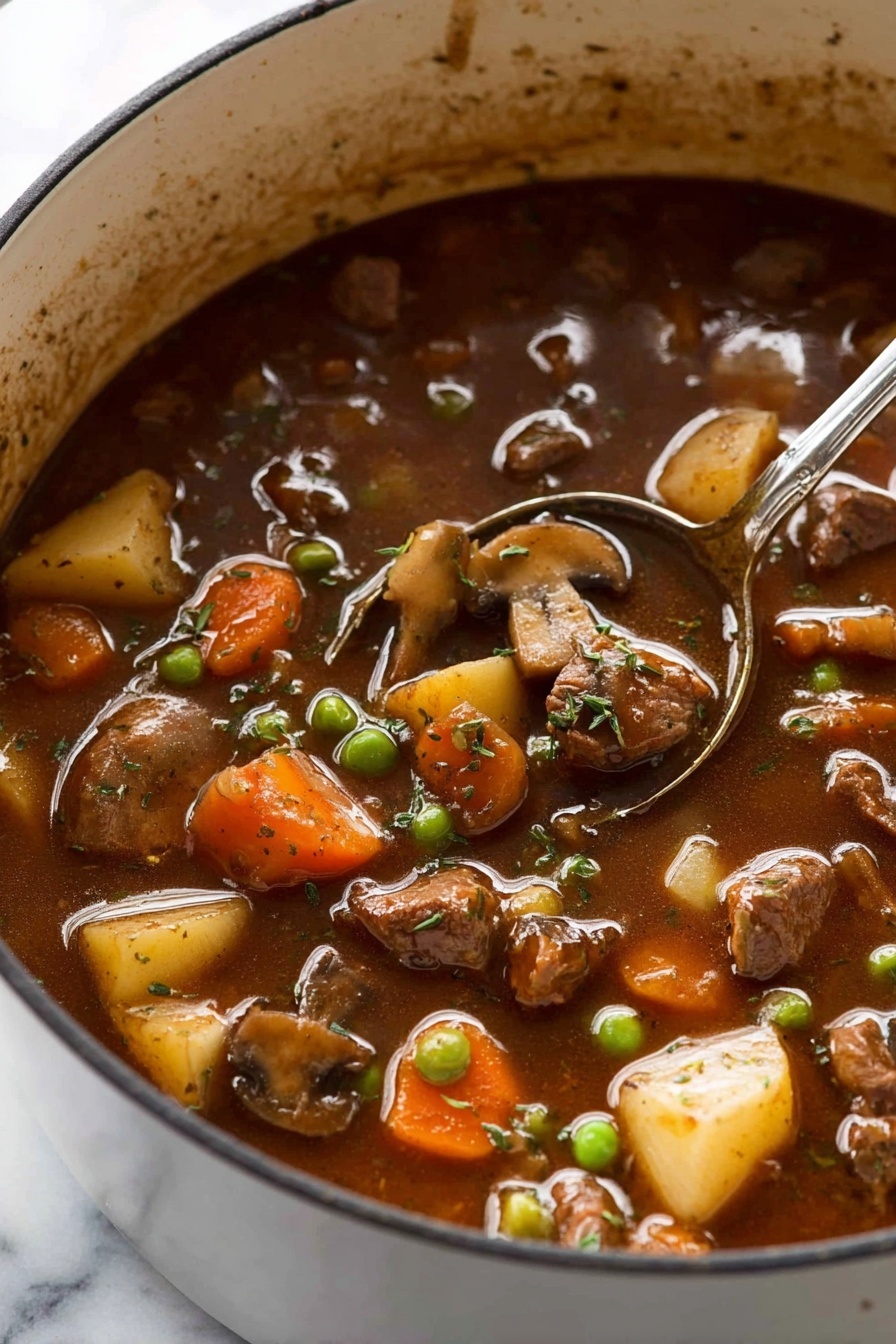
Ingredients & Why They Work
The magic of this Vegetable Beef Soup with Guinness and Vegetables Recipe lies in how these ingredients blend—each one bringing something unique. From the tender beef soaking up that bittersweet Guinness aroma to the fresh, crisp vegetables, it’s a balance of earthy and vibrant flavors.
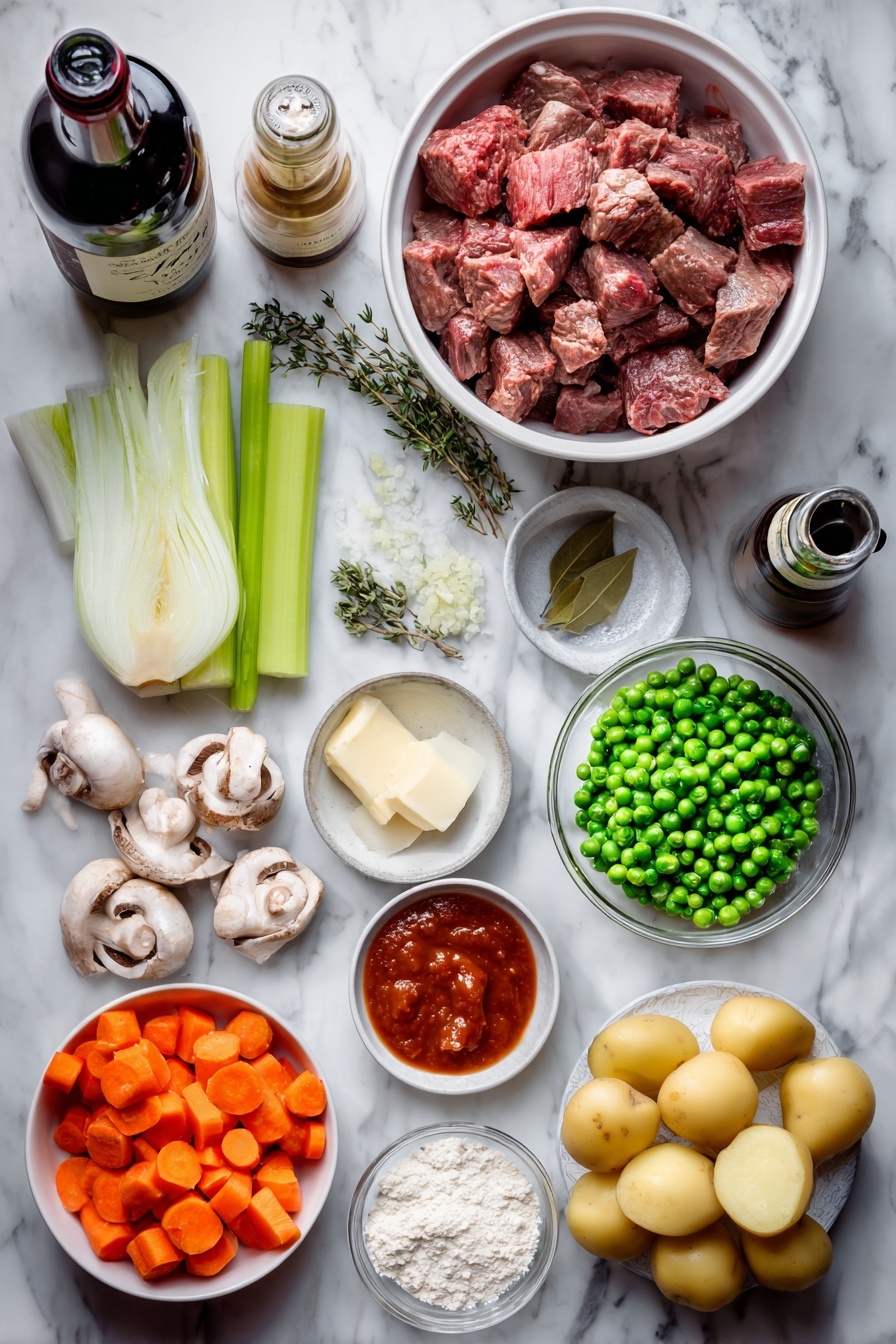
- Stewing beef: Look for a cut with some marbling, like chuck or boneless short rib; the fat melts during slow cooking, making the beef tender and flavorful.
- Onion and garlic: These aromatics are the base of amazing flavor; don’t rush this step, letting them soften releases natural sweetness.
- Celery and carrots: Classic soup veggies that add subtle sweetness and texture.
- Flour: Helps thicken the broth and give it that slightly silky body.
- Beef broth/stock: Use low sodium so you can control salt levels; it provides a rich, meaty foundation.
- Guinness, stout, or dry red wine: This is the superstar ingredient that elevates the soup with its deep, malty notes and a slight bitterness that balances the richness.
- Tomato paste: Adds umami and a touch of acidity that brightens things up.
- Bay leaves and thyme: Classic herbs that bring warmth and earthiness without overpowering the dish.
- Frozen peas and potatoes: Added later to keep their textures just right; the potatoes make it hearty, while peas add a fresh pop.
- Mushrooms (optional): Cooking them separately in butter adds an extra layer of savory goodness if you have them on hand.
Make It Your Way
I’m all for making this Vegetable Beef Soup with Guinness and Vegetables Recipe your own. I often experiment with swapping veggies based on what I have and sometimes sneak in a bit more spice if I want that little kick of warmth. It’s forgiving, so don’t hesitate to tweak!
- Variation: Sometimes I add a splash of Worcestershire sauce when I’m out of Guinness—it gives a similar depth. Another favorite is swapping peas for fresh green beans when they’re in season; it changes the texture in a lovely way.
Step-by-Step: How I Make Vegetable Beef Soup with Guinness and Vegetables Recipe
Step 1: Brown the Beef for Maximum Flavor
Heat a tablespoon of olive oil until it’s really hot in a large, heavy pot. This is crucial: a hot pan helps get a beautiful sear on the beef, locking in juices. Pat your beef cubes dry – this prevents steam and promotes browning – then season with salt and pepper. Brown the beef in batches; don’t overcrowd the pan or you’ll end up steaming instead of searing. Once browned, set the beef aside. Your kitchen will start smelling incredible at this point!
Step 2: Build the Flavor Base
Add a touch more oil if the pot looks dry, then toss in your chopped onions and garlic. Cook for about 2 minutes until fragrant and softened but not browned. Next, add the celery and carrots, cooking for another 2 minutes. This combination forms the flavor backbone of your soup, so take your time. Then sprinkle the flour over the veggies and stir well – this coats everything and helps thicken your broth later.
Step 3: Pour in Liquids and Simmer
Slowly add the beef broth while stirring constantly to avoid lumps. Next, add the Guinness or your chosen stout/wine, water, tomato paste, bay leaves, and thyme. Stir everything together to combine. Return the browned beef to the pot, cover, and reduce heat to medium-low. Let it simmer gently for about 1 hour and 15 minutes – this slow cook is where that tough beef turns wonderfully tender.
Step 4: Add Vegetables and Final Touches
After the initial simmer, add the cubed potatoes and peas, then cook for another 20 minutes uncovered. This lets the broth thicken and the potatoes soften perfectly. If you’re including mushrooms, sauté them separately in butter until nicely browned, and stir them in during the last 5 minutes. Finally, taste and season with salt and plenty of fresh ground pepper—this step really ups the flavor.
Top Tip
Having made this recipe countless times, the real game-changer is how you brown your beef and manage the simmering temperature. Slow and steady wins the race when it comes to tenderness and flavor.
- Pat the Beef Dry: Moisture is the enemy of good browning; always dry your beef thoroughly before seasoning.
- Don’t Rush the Browning: Brown the beef in batches to get a deep, caramelized crust—it adds layers of flavor to your broth.
- Simmer Gently: Keep the heat just low enough to bubble softly to avoid toughening the meat.
- Season at the End: Add salt and pepper near the end once the flavors have melded; it helps you avoid over-salting.
How to Serve Vegetable Beef Soup with Guinness and Vegetables Recipe
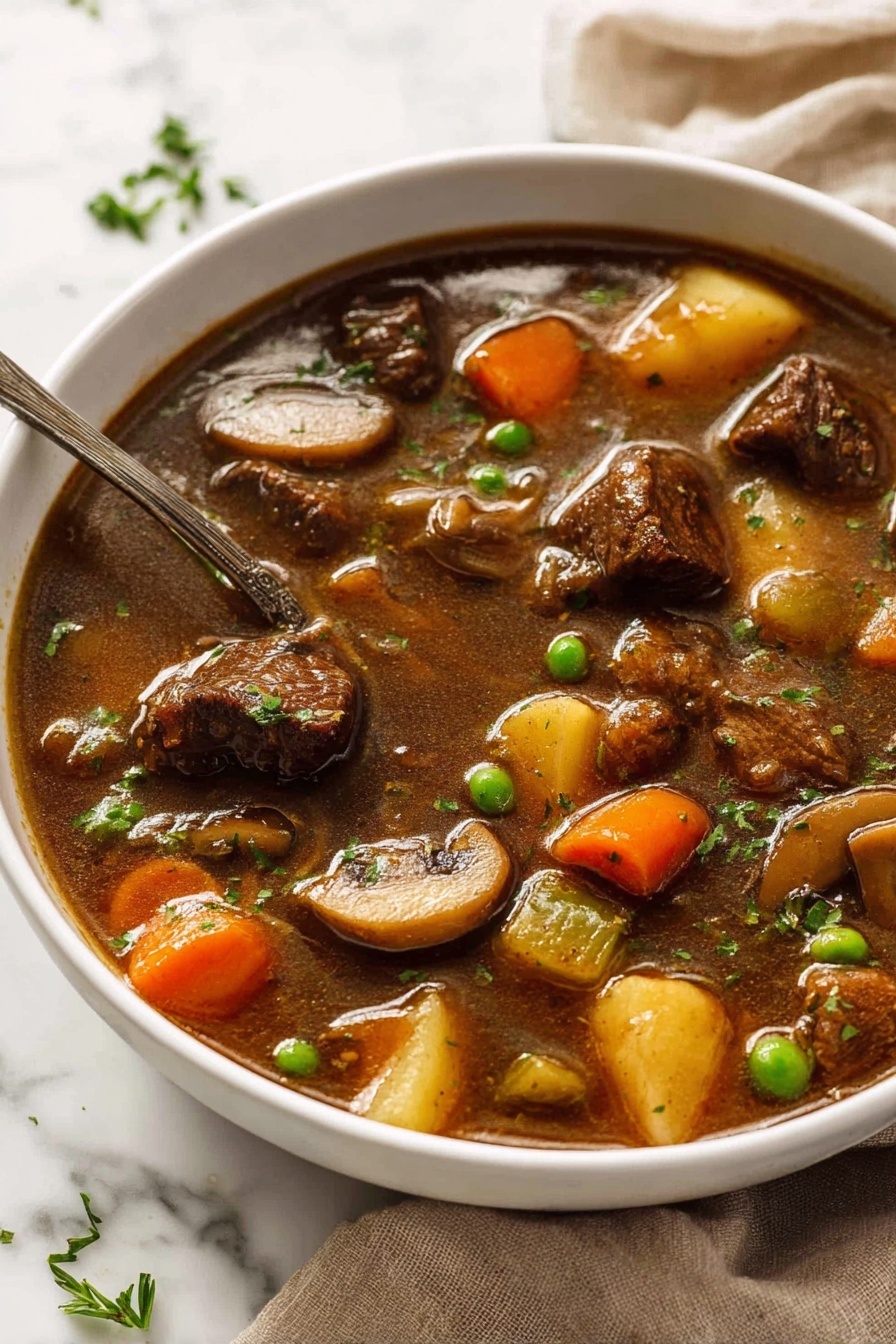
Garnishes
I love topping this soup with a sprinkle of fresh parsley—adds a pop of color and brightness. Sometimes I add a dollop of sour cream or crème fraîche for creaminess that contrasts the rich broth beautifully.
Side Dishes
Crusty bread is a must-have here. I often serve it alongside quick cheesy garlic bread or even homemade Irish soda bread. They’re perfect for dipping and soak up every last bit of that delicious broth.
Creative Ways to Present
For a special occasion, I like to ladle the soup into pretty bowls and serve with a fresh herb sprig on top. You can even serve it in hollowed-out bread bowls—makes it really fun and rustic. Pairing it with a side salad with tangy vinaigrette helps balance the richness for a crowd-pleasing meal.
Make Ahead and Storage
Storing Leftovers
This soup actually tastes better the next day as the flavors deepen. I usually store leftovers in airtight containers in the fridge for up to 4 to 5 days. Just reheat gently on the stove to keep the beef tender and veggies intact.
Freezing
I freeze portions regularly. Make sure to cool the soup completely before transferring to freezer-safe containers or bags. It freezes beautifully and keeps for up to 3 months. When you’re ready to enjoy, thaw overnight in the fridge and reheat slowly.
Reheating
Gentle reheating is key. I warm it on low heat, stirring occasionally. Adding a splash of broth or water helps loosen the soup if it thickened too much in the fridge or freezer. Avoid boiling to keep the beef from drying out.
Frequently Asked Questions:
Yes! While Guinness and stouts offer a unique richness and slight bitterness that complements the beef, you can substitute with a dry red wine like Cabernet Sauvignon or Merlot. If avoiding alcohol, adding crushed tomatoes and Worcestershire sauce can provide a similar depth of flavor.
Look for stewing or braising cuts such as chuck, boneless short rib, or any beef labeled for slow cooking or stew. These cuts have enough fat and connective tissue to break down and become tender when slow simmered, which is essential for that fall-apart texture.
Absolutely! You can brown the beef on the stove first for extra flavor, then add all ingredients to a slow cooker. Cook on low for 6 to 8 hours or on high for 3 to 4 hours until beef is tender and vegetables are cooked through.
If your soup turns out too thin, you can simmer it uncovered for a bit longer to reduce and concentrate the flavors. Alternatively, stir in a slurry made from flour or cornstarch mixed with cold water, cooking for a few minutes until thickened. Make sure to add these gradually and stir well to avoid lumps.
Final Thoughts
This Vegetable Beef Soup with Guinness and Vegetables Recipe holds a special place in my heart—and my kitchen—because it balances rustic comfort with real depth of flavor. Every time I make it, it feels like a celebration of simple ingredients done right. Give it a go; you’ll have a soup that’s so satisfying you’ll want to make it a staple in your own recipe box.
Print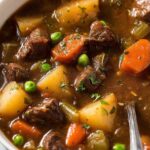
Vegetable Beef Soup with Guinness and Vegetables Recipe
- Prep Time: 15 minutes
- Cook Time: 1 hour 50 minutes
- Total Time: 2 hours 5 minutes
- Yield: 5 servings
- Category: Soup
- Method: Stovetop
- Cuisine: Irish
Description
A hearty and flavorful Vegetable Beef Soup featuring tender stewing beef simmered with fresh vegetables and aromatic herbs, perfect for a comforting meal in cooler weather.
Ingredients
Main Ingredients
- 1.5 tablespoon olive oil, separated
- 500g/1 lb stewing beef, cut into 1.75cm / ⅔" cubes
- ½ teaspoon salt and pepper
- 1 onion, chopped
- 3 garlic cloves, minced (1 tbsp)
- 2 celery stalks, cut into 0.8 cm / ⅓" slices
- 3 carrots, cut into 0.5 cm / ⅕" thick slices (halve larger ones)
- 4 tablespoon flour
- 2 ½ cups (625ml) beef broth/stock, low sodium
- 1 ½ cups (375ml) dry red wine, Guinness beer or stout
- 1.5 cups (375ml) water
- 2 tablespoon tomato paste
- 2 bay leaves
- 1 teaspoon dried thyme
- 1 cup frozen peas
- 2 potatoes (any), cut into 1.5cm / ⅔" cubes
Buttery Mushrooms (optional)
- 1 tablespoon (15g) butter or oil
- 200g/ 6oz small mushrooms, quartered or halved
Instructions
- Heat oil and prepare beef: Heat 1 tablespoon oil until very hot in a large, heavy-based pot over high heat. Pat beef dry with paper towels, then sprinkle with salt and pepper.
- Brown the beef: Brown beef aggressively in 2 or 3 batches, adding more oil if needed. Remove browned beef into a bowl.
- Sauté aromatics: If pot looks dry, add a touch more oil. Add garlic and onion, cook for 2 minutes until fragrant.
- Add vegetables: Add carrot and celery, cook for 2 minutes or until onion is translucent.
- Thicken the base: Stir in flour, then slowly pour in beef broth while constantly stirring to avoid lumps.
- Add liquids and herbs: Add beer, water, tomato paste, bay leaves, and thyme. Stir well, then return beef to the pot.
- Simmer the soup: Cover pot and adjust heat to medium low, allowing it to bubble gently. Simmer for 1 hour 15 minutes or until beef is tender.
- Add potatoes and peas: Add potatoes and peas to the pot, simmer uncovered for a further 20 minutes.
- Cook buttery mushrooms (optional): In a skillet, melt butter over medium-high heat. Add mushrooms and cook for 5 minutes until browned. Season with salt and pepper. Add cooked mushrooms to the soup in the last 5 minutes of cooking.
- Final seasoning and serving: Adjust salt and pepper to taste, ladle soup into bowls, sprinkle with parsley, and serve with crusty bread if desired.
Notes
- Beef: Use stewing or braising beef like chuck or boneless short rib, ideally well-marbled for flavor.
- Liquids: Red wine, Guinness, or stout add rich flavor. For a non-alcoholic substitute, use a 400g can of crushed tomatoes plus 2 teaspoon Worcestershire sauce.
- Storage: Soup tastes better the next day. Keeps 4-5 days refrigerated and freezes well.
- Mushrooms: Optional but add great richness and texture.
- Serving suggestion: Pair with cheesy garlic bread or Irish soda bread for a complete meal.
Nutrition
- Serving Size: 1 bowl (about 300g)
- Calories: 350 kcal
- Sugar: 5 g
- Sodium: 450 mg
- Fat: 15 g
- Saturated Fat: 5 g
- Unsaturated Fat: 8 g
- Trans Fat: 0 g
- Carbohydrates: 25 g
- Fiber: 5 g
- Protein: 30 g
- Cholesterol: 70 mg

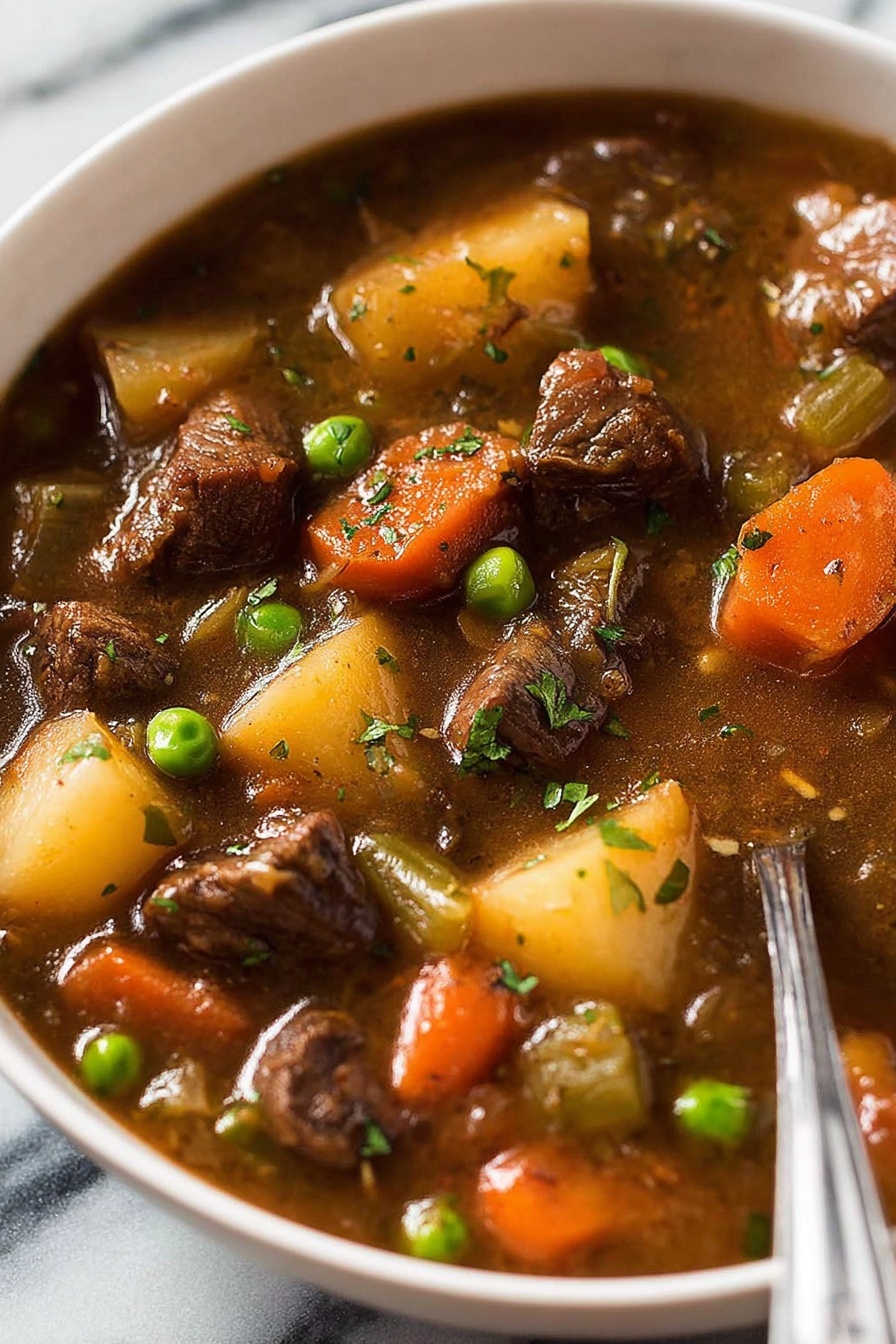
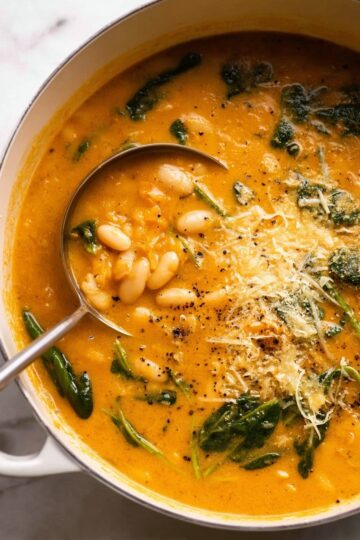
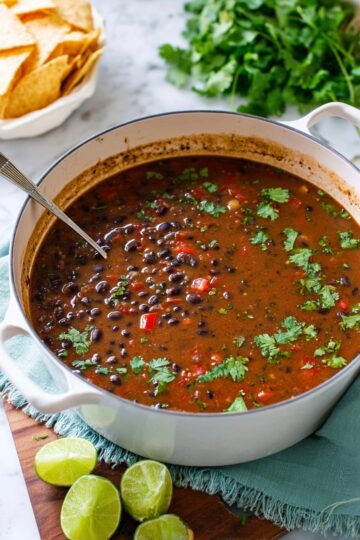
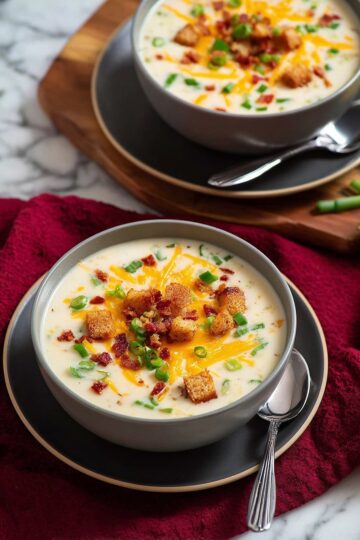
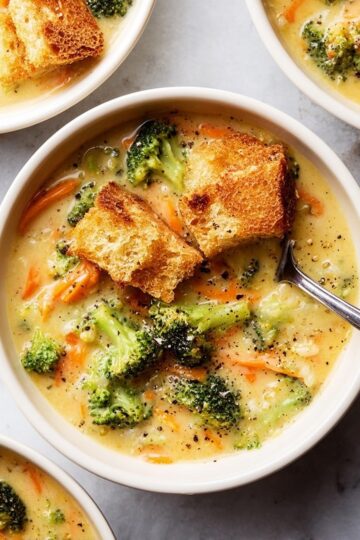

Leave a Reply